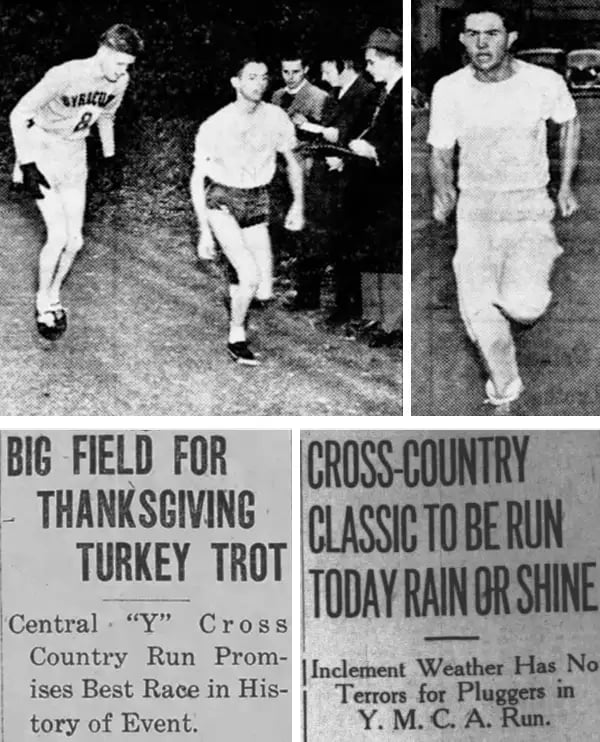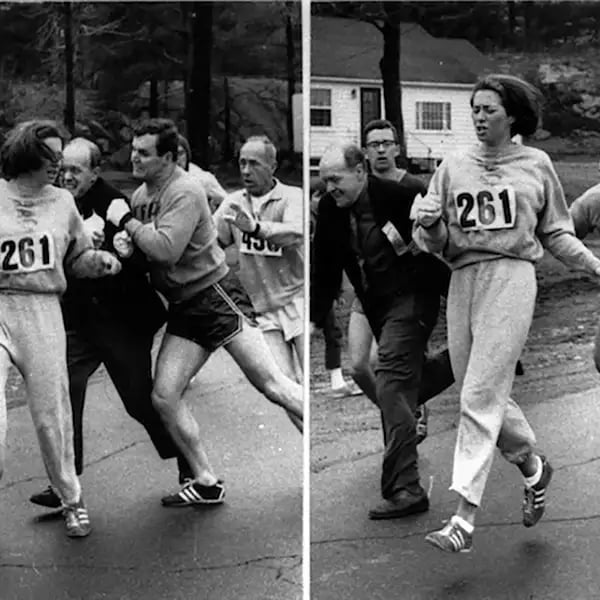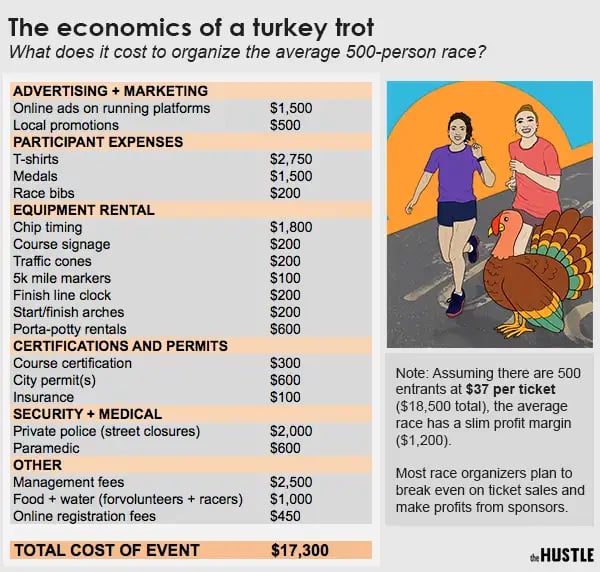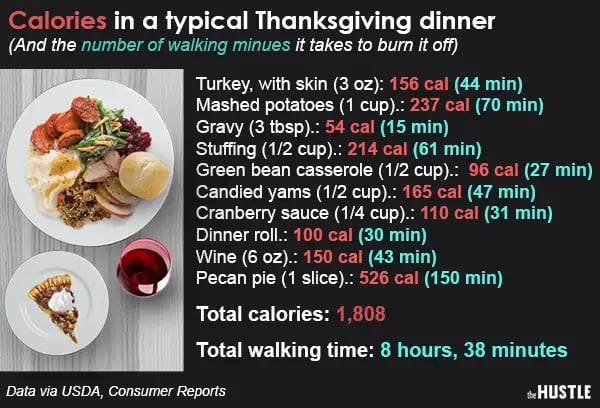On Thanksgiving morning, Janet Hartford wakes up her husband and two daughters at dawn, shoves a few Lärabars down their gullets, and drives the family 15 miles north through the hemlock trees of Eastern Pennsylvania.

In the cool air, she disrobes her neon windbreaker. She skips in place, exhales a cloud of condensation. She checks — for the fourth time — that her New Balance 404s are properly knotted. There is no room for error: It’s motherf*cking turkey trot day.
Every year, 1,000,000 runners toe the starting line at more than 1,000 turkey trot races, across America, making Thanksgiving the most popular day of the year to run a race.
But how did this humble event turn into a national phenomenon? Why is the most gluttonous holiday on record synonymous with exercise? And what are the economics behind your typical trot?
The humble origins of the turkey trot
History’s first documented turkey trot can be traced to Buffalo New York, on Thanksgiving Day of 1896, the same year the modern Olympics debuted.
Put on by the local Y.M.C.A., the 8-kilometer race (just under 5 miles) featured 6 competitors — only 4 of whom actually finished (as Runner’s World notes, one competitor dropped out at the 2-mile mark, and another ate a “late breakfast refused to keep in its proper place”). The winner, Henry A. Allison, triumphed in a time of 31 minutes, 12 seconds (about 6:16 per mile).

The event slowly gained popularity and other small turkey trots popped up across the country.
For many years, running was considered a fringe sport for weirdos and masochists, and was thought to be detrimental to one’s physical and mental health. That is, until 1961, when a Kiwi by the name of Arthur Lydiard launched the world’s first jogging club in New Zealand and extolled the sport’s cardiovascular virtues.
On a trip abroad in 1966, Bill Bowerman — a future co-founder of Nike — witnessed Lydiard’s movement, and was impressed. He returned to the United States and published “Jogging,” a tome that sold 1m copies and launched a running frenzy.
In the wake of the international success of prominent American runners like Steve Prefontaine and Frank Shorter, turkey trots quadrupled in number during the 1970s.
These were not the turkey trots of today: They were exclusively for men, and were extremely competitive. As Rich Harshbarger, CEO of the non-profit Running USA, tells us, “It was all guys in short shorts, with porn star mustaches.”
In the early days of turkey trots, women were not welcome. Most physiologists were still trotting out the tired narrative that women were “too fragile” for running. The International Olympic Committee barred them from competing in any event 5k-meters (3.1 miles) or longer.
Women who did compete in road running races often had to do so under male pseudonyms — like Kathrine Switzer, who famously defied the male-only Boston Marathon rule in 1967 and completed the race despite nearly being forced off the course mid-way.

By the mid-1980s, the rules finally began to change — and Olympic distance runners like Joan Benoit Samuelson and Mary Decker inspired a broader sector of women across America to enter local races.
As races neared gender parity, they naturally became more social events. Turkey trots were no longer just for solitary, mustachioed men: They were a family affair.
Today, Thanksgiving Day is the most popular running day in America: Across the country, more than 1m people run in 1k+ events — more than Christmas, St. Patrick’s Day, or the 4th of July.
“It’s become a great day to bring people together,” says Harshbarger. “Trots aren’t necessarily as competitive: There are costumes, mashed potato miles, drumstick dashes… the whole family comes out.”
And with families, comes big business
What was once a gaggle of six men has since become a spectacle played out in hundreds of towns across America.
A typical turkey trot may draw 500 to 1k contestants, but depending on the event and city, field sizes can range from less than 50 to more than 10k. Races like the Dallas Turkey Trot and the Silicon Valley Turkey Trot host as may as 25k runners.
And they aren’t cheap: We analyzed a random sample of 50 races and the average entry fee, including “Early Bird” specials, came out to $37. With 1m runners every Thanksgiving, that’s nearly $40m in revenue.
Why is it so pricey to run 3.1 miles in a turkey costume, in a sea of sweaty bodies? A local race organizer we spoke with broke down what a typical 500-person race costs:

A turkey trot — especially one run on the streets of a major city — requires a surprising amount of resources, including off-duty police (at an overtime rate) to block off streets, a paramedic on standby, a slew of equipments rental (ranging from traffic cones to portable toilets), permits, insurance, and, of course, t-shirts.
Race organizers generally break even on ticket sales. Assuming an average entry fee of $37, our 500-person race example would gross $18,500, leaving just a $1,200 margin after expenses.
Most races rely on sponsors to push them into profitability: The average trot seems to secure anywhere from $5k to $7k from local businesses or large corporations.
Any profits made by the majority of turkey trots — large or small — usually go to charity. For instance, in its 13-year history, the Silicon Valley Turkey Trot (one of America’s largest Thanksgiving races) has raised $5m for 3 charities.
If the giving component doesn’t convince you to lace up for next year’s local trot, maybe the calories in your run-of-the-mill Thanksgiving dinner will:

It worked for Janet Hartford.
After rolling solo at her local Pennsylvania turkey trot for nearly a decade, she finally found a sales pitch that worked on her husband.
“I told him, ‘Look man, if you want to get anywhere near that pecan pie, you’ve got to run the turkey trot,’” she says. “He’s been 3 years in row.”
This husband and wife team wants you to sleep in a 5-star hotel every night
(Or at least feel like you are.)
The year was 2014. Rich and Vicki Fulop had just spent a lovely night at a luxury hotel with sheets so comfortable, they just had to have them….that is, until they were told those crisp sheets cost over a grand.
With price gouging like that, it’d practically be cheaper to make ‘em themselves.Which is exactly what they decided to do with Brooklinen.
The bedding 500k happy sleepers trust, direct to you
Thanks to the couple’s finance-fueled frustration, luxury sheets are now affordable enough for comfort enthusiasts everywhere.
It starts with Brooklinen’s direct-to-consumer model, which cuts out the middleman and passes the savings on to you.
That allows them to offer the highest quality sheets at an affordable price, and clearly it’s working out — Brooklinen bedding has over 30K 5-star reviews and has expanded to pillows, robes, towels, and everything in between.
If you’re ready to invest in the best sleep money can get, now’s the time. Get up to 20% off during their biggest sale of the year this Black Friday and Cyber Monday.

